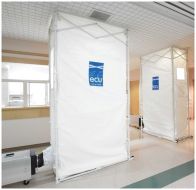Things to Consider When Choosing the Right Dust Containment Solution

Wherever there is work to be done, there is dust. Most of the time, it is sufficient to use painter’s tape and plastic to shield adjacent rooms from the airborne filth that lands everywhere. Difficulties arise when this is not enough. Maybe there is abatement work to be done in a room containing specialized equipment that must remain sterile and cannot be moved. Maybe there is drywall that needs replacing in a hospital room containing patients on ventilators that are too medically fragile to be relocated. Whatever the case may be, there are always scenarios where high priority dust containment is required.
What is an ECU?
ECUs, or Environmental Containment Units, work by making an airtight seal with the environment. When used correctly, no airborne contaminants will travel in or out of the unit. A typical ECU will be a tent-like structure made of a soft canvas material, equipped with a combination of zippers, plastic and Velcro. There are incoming and outgoing valves that allow the filtered air to enter the space and then exit. When the right mechanized filter devices are connected to the valves, the ECU’s effect will be maximized. The level of protection that the ECU will provide for dust containment ultimately depends on the equipment attached to the valves.
The utility of HEPA filters
One of the more common devices that are attached to ECUs are High Efficiency Particulate Air, or HEPA filters. These have the ability to capture particulate down to 0.3 micrometers in size, which includes viruses and volatile organic compounds found in paint and solvents. Because these compounds are common in construction and abatement, it makes for an ideal compliment to be able to filter these away in addition to simple dust particulate.
When a HEPA filter is used on an ECU, the occupant is surrounded by air that has been filtered, because there is a mechanized fan that constantly sucks air out, puts it through the filter and forces it back in. This is a far more robust dust containment solution than an air scrubber. While an air scrubber is also a HEPA filter that is attached to a mechanized fan, the fact that it is nothing more than a portable device places limits what it can do. With an ECU there is no free movement of air because everything is contained. An air scrubber, by contrast, can really only dilute the amount of contaminants in the air. Suppose it takes a scrubber an hour and a half to filter the room’s air volume. During this time, new contaminants are free to enter the room, which means that there will always be some level of baseline contaminant present. ECUs offer a nice solution to this problem by creating an isolated space.
The efficacy of negative air machines
The next level of protection for an ECU is to use what is called a negative air machine. A negative air machine uses an even more powerful fan than a simple HEPA device. The idea is that the additional sucking power creates a differential in air pressure, which acts as a barrier against the migration of the contaminants. If the goal is to keep the contaminants away from someone insulating someone in an ECU from surrounding contaminants, the machine can create a barrier of positive pressure. Essentially, there would be a controlled excess of air going into the machine at all times, causing a balloon effect inside the unit’s walls. This would be an even more robust dust containment strategy than only relying on the HEPA, because there is now another physical barrier stopping the contaminated air from moving inward.
One drawback with ECUs is that they are far more expensive to use than an air scrubber, and they tend to get more expensive as the level of protection increases. One way to lower the ECU’s cost is to use a disposable envelope. A disposable envelope is an ECU that is made of disposable material, designed for a one-time-use. The idea is to hook up the normal filter and fan hardware to it and dispose of the structure afterward. This is ideal for short-term dust containment. The good news is that solutions have arrived to serve almost any level of dust containment threshold, with some level of flexibility on the budget. Now it is just a matter of finding the right solution for the right job.
